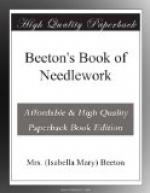[Illustration: 441.—Point de Valenciennes (Valenciennes Stitch).]
3rd row: 5 close button-hole in the 9 of previous row, 1 short point de Bruxelles, 2 close in the Bruxelles stitch, 1 short point de Bruxelles, 5 close, 1 short point de Bruxelles, 2 close, l short, 5 close, 1 short, and repeat. 4th row: 5 close, 1 short point de Bruxelles, 2 close, 1 short, 5 close, 1 short, 2 close, l short, and repeat. Continue the rows until sufficient of the pattern is worked.
[Illustration: 442.—Point d’Alencon, with Twisted Stitch.]
No. 442. POINT D’ALENCON.—This stitch is used to fill up narrow spaces where great lightness is required. Point d’Alencon is worked under and over in alternate stitches, like hem stitch. Nos. 442 and 443 show point d’Alencon. In No. 442 a twisted stitch is worked over the plain point d’Alencon, which is clearly shown in No. 443; this twist is made by passing the thread three times round each plain bar, and working the knot shown in illustration No. 442 over both strands of the bar.
[Illustration: 443.—Point d’Alencon, with Button-hole Stitch.]
The POINT D’ALENCON No. 443 is a festoon of close button-hole stitch worked over the plain bars.
[Illustration: 444.—Point d’Angleterre (Open English Lace).]
No. 444.—POINT D’ANGLETERRE (Open English Lace).—Open English Lace is thus worked:—Cover the space to be filled in with lines of thread about one-eighth of an inch apart, then form cross lines, intersecting those already made and passing alternately under and over them; work a rosette on every spot where two lines cross, by working over and under the two lines about 16 times round, then twist the thread twice round the groundwork thread, and begin to form another rosette at the crossing threads. No. 445 shows this stitch much enlarged.
[Illustration: 445.—Point d’Angleterre (Enlarged).]
No. 446,—POINT TURQUE (Turkish Stitch).—This easy and effective stitch looks well for filling either large or small spaces; the thread employed should be varied in thickness according to the size of the space to be filled. 1st row: Work a loop, bringing the thread from right to left, passing the needle through the twist and through the loop, draw up tight and repeat. 2nd row: 1 straight thread from right to left. 3rd row: Work the same as first using the straight thread in place of the braid, and passing the needle through the loop of previous row, as shown in illustration No. 446.
[Illustration: 446.—Point Turque.]
No. 447.—CORDOVA STITCH is useful for varying other stitches. It resembles the point de reprise of guipure d’art, and is worked in a similar manner over and under the side of squares formed by straight and parallel lines. (See No. 448.)
[Illustration: 447.—Point de Cordova (Cordova Stitch).]
No. 448.—POINT DE REPRISE.—This stitch is worked by darning over and under two threads, forming a triangle. The space is filled by parallel and cross-way bars, placed at equal distances, and on the triangles thus produced point de reprise is worked.




